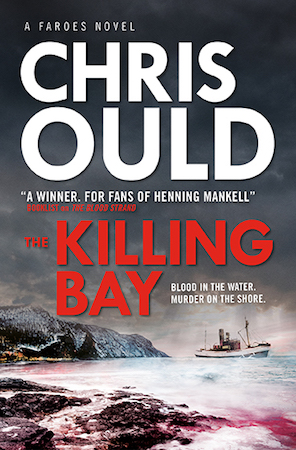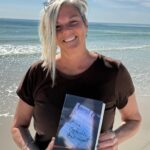Welcome to the Faroe Islands by Chris Ould
 Welcome to the Faroe Islands
Welcome to the Faroe Islands
Sitting in the middle of the north Atlantic between Norway and Iceland, the Faroe Islands have been well off the travel destination map for a long time. However, in the last couple of years these remote, jagged islands have – perhaps unexpectedly – found themselves featuring on the top ten lists of places to visit from many notable travel magazines and websites including National Geographic. To mark the publication of The Killing Bay, here are ten random facts (and some tips) for people who want to go and see this intriguing archipelago for themselves.
It rains. Set where they are, it’s probably not surprising that on average it rains in the Faroes on 300 days of the year. The good news, however, is that whatever the weather is doing in Tórshavn or on Suðuroy, the chances are it’s doing the exact opposite a few kilometres away, especially if there’s a mountain in between. Fog and sea mist can sit like a wet towel over one place for days, but just use it as an excuse to go and see what another place is like.
You’ll need a car. There’s a really good bus service (and in the Tórshavn area it’s free) which can take you pretty much anywhere on the islands, but they may not come along very often. To really get the most out of the islands you’ll want to be able to stop when you like, follow that interesting side road, or just drive somewhere else to get away from the aforementioned rain. A car is also a great repository for boots, waterproofs and bags so you’re never without them.
Language. Faroese is, if not impenetrable, then definitely not for the faint-hearted. Basically, nothing sounds as it looks, and even when it does it probably doesn’t mean what you think. That said, a few basic phrases are pretty easy to learn and they’ll stand you in good stead with the locals who really appreciate anyone who has a go. In all the time I’ve spent in the Faroes I’ve only come across three people who didn’t speak any English at all, so for the most part there’s never any real difficulty asking directions or just having a chat. The Faroese have a reputation for being a little reserved, but it doesn’t usually last.
Whales. Okay, yes, the Faroese do kill pilot whales and in recent years organisations like Sea Shepherd have made a lot of hullabaloo about that. However, pilot whales are a traditional source of food for the Faroe Islanders going back a thousand years, and most of the results you’ll get from googling “Faroes” and “whales” are likely to be based on “alternative facts”. As a result the subject of the grind can be pretty contentious, so it’s probably not the best conversational gambit. However, if you’re open to a balanced and objective discussion, few Faroese will close the door on you.
Alcohol. Until relatively recently the Faroes were pretty much teetotal and alcohol is still not freely available in supermarkets and corner shops. (What they do stock is known locally as “piss beer” which speaks for itself.) If you want something better you can go to the duty free when you get off the plane or visit the “rusan,” which is the state run alcohol store. Be warned, though, opening hours are short and not always convenient, so it pays to plan ahead. Other than that there are plenty of bars in Tórshavn which stay open until four or five in the morning on Fridays and Saturdays – a time when the Faroese really let their hair down.
 Sights. The main reason you’ll probably go the Faroes is to see a landscape that wouldn’t be out of place in Game Of Thrones or Lord Of The Rings, or for the bird life that colonies the islands. Either way, you’ll need a wide angle and a telephoto lens if you’re a serious photographer and plenty of space on your memory cards, regardless. With thousand-foot cliffs, waterfalls, picturesque harbours, fjords and mountains practically everywhere in the islands has something stunning to look at.
Sights. The main reason you’ll probably go the Faroes is to see a landscape that wouldn’t be out of place in Game Of Thrones or Lord Of The Rings, or for the bird life that colonies the islands. Either way, you’ll need a wide angle and a telephoto lens if you’re a serious photographer and plenty of space on your memory cards, regardless. With thousand-foot cliffs, waterfalls, picturesque harbours, fjords and mountains practically everywhere in the islands has something stunning to look at.
Money. The Faroese króna is linked to the Danish krone, but the most relevant issue is spending power. By and large the Faroes aren’t a cheap destination (from a British perspective, anyway) and despite Sarah Lund’s Faroese knitwear being at source, you aren’t going to come away with the equivalent of a Turkish bazaar bargain. In a restaurant a main course alone will start at about 200 kr, which for a Brit makes it even more expensive than London and a little more so than Copenhagen. On the plus side, however, beer is about the same price and petrol is actually cheaper than in the UK.
Food. Speaking of meals, the first rule is never to assume you will be able to find anywhere to eat outside Torshavn. True, the larger towns like Klaksvík and Runavík do have restaurants and/or cafes, but in my experience – and especially off season – you can’t rely on them being open, even if the time on the door says they should be. So it’s wise to stock up before heading out into the wilds, and although the filling stations (tank stations) can provide hotdogs and coffee, they’re also thin on the ground.
Tunnels. The Faroese love tunnels. There are nineteen of them linking islands and going through inconvenient mountains, but if you’re a nervous driver (or claustrophobic) you might want to check out which ones you’ll be driving through to reach your intended destination. The tunnels on the main routes are good, wide and lit, but in order to get to some of the more remote areas you need to go through some which are single-lane and dark. Very dark. If that doesn’t appeal then drive through the subsea tunnel between Eysturoy and Borðoy and enjoy the lighting display at the deepest point.
Taste the difference. If you really feel like treating yourself get a table at Koks (in Hotel Føroyar) and try their award winning variations on traditional dishes. But if you’re lucky enough to be in someone’s home and you’re offered the chance to taste the local delicacy skerpikjøt, don’t say no! It’s wind-dried mutton and eaten on black bread it is fantastic. Locals claim that each piece tastes different, depending on where it was cured, and while I can’t entirely vouch for that, it is just one of the reasons I keep going back.
The Killing Bay is available from Titan Books.












